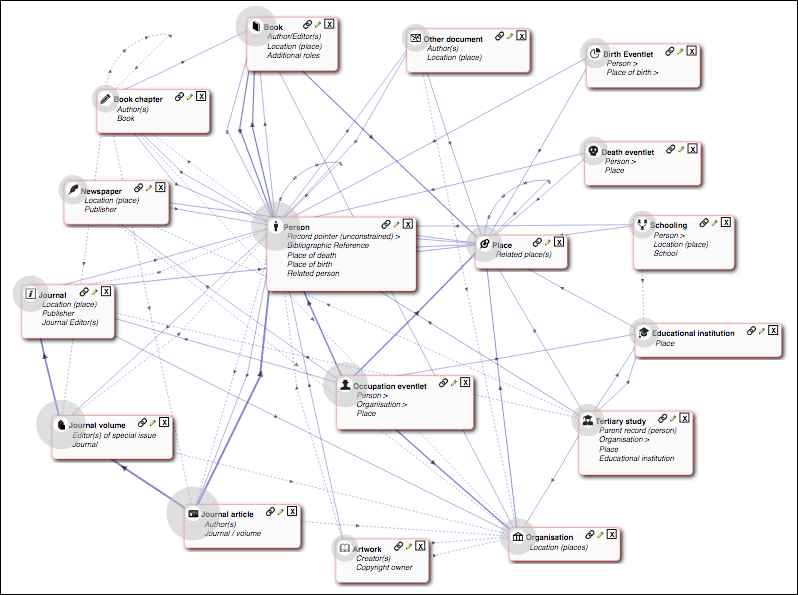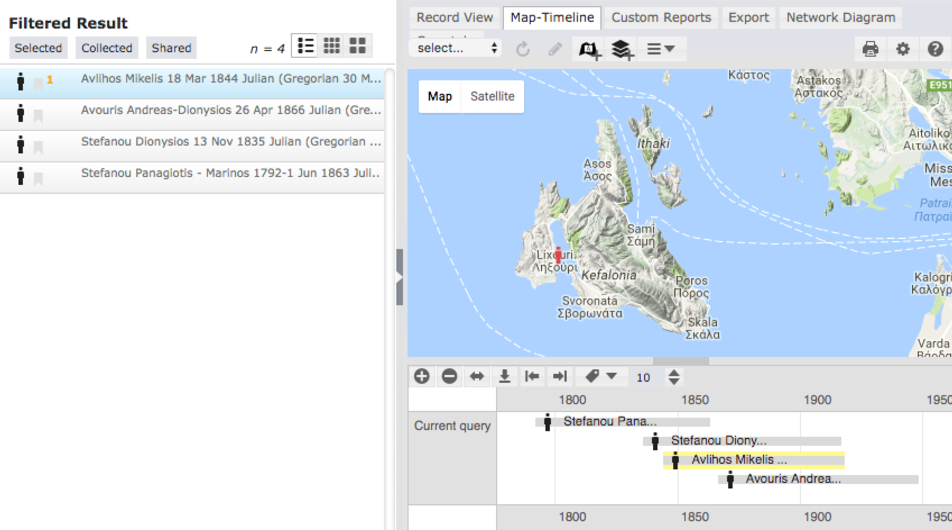Mapping Island Lives
Mapping Island Lives
This project began over a decade ago, at the Modern Greek History Research Centre of the Academy of Athens. In its original form it was named “Eptanesian prosopography, 19th-20th centuries” (in Greek) and was an attempt to collect prosopographical information on persons who lived in the nineteenth and the early twentieth centuries, born in or originating from the Ionian Islands (“Eptanisa” in Greek, i.e. Seven Islands), a complex of small islands off the Western coast of Greece. As the project progressed, it became clear to me that, beyond its obvious encyclopaedic value, the material could be used to document, in a more dynamic way, the course of the political, social and cultural history of the region. Unlike the lands of mainland Greece, these islands had not been subjected to the four-century long Ottoman rule, but were governed by Venice and Britain for most of that time.
Following the creation of the independent state of Greece in 1830, the islands joined the new state in 1864. However, they preserved their distinct political, social and cultural identity, the result of their distinct past, until well into the twentieth century. The database currently under development is an attempt to map the lives of their political, professional and cultural elites during a period beginning with the end of the Venetian rule and ending with the assimilation of Ionian into Greek society.
Following the creation of the independent state of Greece in 1830, the islands joined the new state in 1864. However, they preserved their distinct political, social and cultural identity, the result of their distinct past, until well into the twentieth century. The database currently under development is an attempt to map the lives of their political, professional and cultural elites during a period beginning with the end of the Venetian rule and ending with the assimilation of Ionian into Greek society.
As the project progressed, it became clear to me that, beyond its obvious encyclopaedic value, the material could be used to document, in a more dynamic way, the course of the political, social and cultural history of the region. Unlike the lands of mainland Greece, these islands had not been subjected to the four-century long Ottoman rule, but were governed by Venice and Britain for most of that time. Following the creation of the independent state of Greece in 1830, the islands joined the new state in 1864. However, they preserved their distinct political, social and cultural identity, the result of their distinct past, until well into the twentieth century. The database currently under development is an attempt to map the lives of their political, professional and cultural elites during a period beginning with the end of the Venetian rule and ending with the assimilation of Ionian into Greek society.
The database is designed to record the main biographical data of each person (name, date and place of birth, date and place of death), information on his/her education, professional career, distinctions, works and bibliographic references. All entities are thus directly or indirectly linked to the Person entity, as shown in the diagram below (Fig 1.).

Fig 1. Structure of the Mapping Island Lives database
The first thing that struck me with Heurist was that, despite its sophistication, you don’t need to be a programmer in order to set up a database. Since I started, I have gradually been building it up from a very simple structure until I reach the degree of complexity that is required by my conceptual model, experimenting as I go along.
Heurist offers all the advantages that I had been unable to find in the software solutions I had used so far. It offers a number of solutions that enable me to record all the complex and often fuzzy information contained in the original sources without compromising their authenticity in the transfer. It allows for the recording of approximate or entirely lacking temporal and spatial information. Use of approximate dates within a user determined range of years, months or days inferred from the historical context enables information to remain in context, however uncertain it may be. For events prior to 1923, I enter dates in the Julian Calendar, the calendar used in the Greek State at the time.
For recording spatial information semantic links with geonames are used in cases where the place names given by the sources can be identified, while spatial relationships between records (wholly within, overlaps, wholly without) are used if the exact position of the given place name (a destroyed settlement for instance) cannot be identified. Relationship types are one type of controlled vocabularies. The other type, named Terms, covers a variety of cases and offers a great degree of flexibility. To imported terms used in other projects and organised hierarchically as controlled vocabularies I add new terms, in particular to the “Organisation types” and “Occupations”. In the case of Occupations, I also add ISCO codes, wherever applicable.

Fig 2. A Person record: attributes (left) and relationships (right).
Light blue fields in both sections are pointers to related records.
I use searches of various types – simple, advanced and faceted to retrieve subsets of the database. For instance, a search for persons, who died from illness gives these results (Fig 3.):

Fig 3. Persons, who died from illness.
Faceted searches allow me to query on data across linked record types. For instance, I can filter for people based on the occupations they held before 1854 (Fig 4.).

Fig 4. Occupations held before 1854.
At the moment, I am focusing on Heurist’s concept of events and eventlets, which I am applying to the person’s birth and death details, and to their education and professional careers. A person’s education and occupation eventlets are time and space related instances of their life. Therefore, provided that the temporal and spatial information is adequate, I will be able to track the careers of individuals over time and space and obtain a more or less clear picture of the insular character of the region and its trend toward assimilation within the Greek state after the middle of the 19th century.

